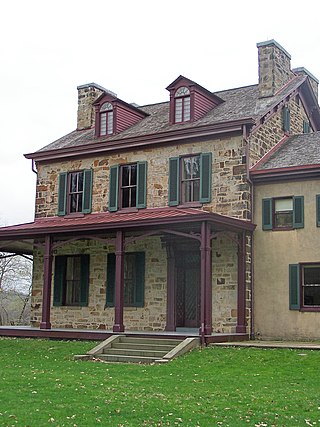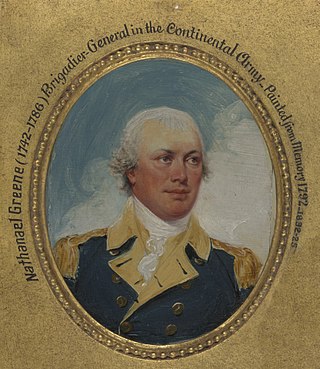Related Research Articles

Greene is a town in Androscoggin County, Maine, United States. The population was 4,376 at the 2020 census. It is included in both the Lewiston-Auburn, Maine metropolitan statistical area and the Lewiston-Auburn, Maine Metropolitan New England city and town area. The central village in the town comprises the Greene census-designated place.

Fayette is a city in Jefferson County, Mississippi, United States. The population was 1,614 at the 2010 census. It is the county seat of Jefferson County.

Springhill Township is a township in Fayette County, Pennsylvania, United States. The population was 2,723 at the 2020 census. The Albert Gallatin Area School District serves the region.

Major-General Nathanael Greene was an American military officer and planter who served in the Continental Army during the Revolutionary War. He emerged from the war with a reputation as one of George Washington's most talented and dependable officers, and is known for his successful command in the Southern theater of the conflict.
The Battle of Averasborough or the Battle of Averasboro, fought March 16, 1865, in Harnett and Cumberland counties, North Carolina, as part of the Carolinas Campaign of the American Civil War, was a prelude to the climactic Battle of Bentonville, which began three days later.

The Tensas River is a river in Louisiana in the United States. The river, known as Tensas Bayou in its upper reaches, begins in East Carroll Parish in the northeast corner of the state and runs roughly southwest for 177 miles (285 km) more or less in parallel with the Mississippi River. The Tensas River merges with the Ouachita River in Jonesville in Catahoula Parish to become the Black River, not to be confused with Black Lake in Natchitoches Parish in north central Louisiana.

The Cataracts of the Nile are shallow lengths of the Nile river, between Khartoum and Aswan, where the surface of the water is broken by many small boulders and stones jutting out of the river bed, as well as many rocky islets. In some places, these stretches are punctuated by whitewater, while at others the water flow is smoother but still shallow.
The Battle of Goodrich's Landing, Louisiana, was fought on June 29 and June 30, 1863, between Union and Confederate forces during the American Civil War. The Confederates attacked several Union regiments, who were composed mostly of black soldiers, in an attempt to disrupt the campaign at Vicksburg, Mississippi.
The Village of Holly Bluff is a small unincorporated community in Yazoo County, Mississippi.

The Battle of Kock’s Plantation was a battle fought July 12–13, 1863, in Ascension Parish, Louisiana, during the American Civil War. It was part of a campaign entitled "Taylor's Operations in West Louisiana (1863)." The Confederate States Army victory left them in control of much of the interior of the Acadiana region.
Disharoon's plantation was located in Tensas Parish, Louisiana and was used as a steamboat landing on the Mississippi River by Union Army General Ulysses S. Grant during the American Civil War.

Scotch Irish Township is one of fourteen townships in Rowan County, North Carolina, United States. The township had a population of 1,820 according to the 2010 census. By the requirements of the North Carolina Constitution of 1868, all counties in North Carolina were divided into townships.
Davis Island is a large island located in the Mississippi River. It lies mostly in Warren County in the state of Mississippi but is also partly in Madison Parish, in the state of Louisiana. It is located about 20 miles southwest of Vicksburg, Mississippi, USA.
Mulberry Grove Plantation, located north of Port Wentworth, Chatham County, Savannah, was a rice plantation, notable as the location where Eli Whitney invented the cotton gin.

St. Francis Xavier Church is a Catholic church at 30–36 West 16th Street, between Fifth Avenue and Avenue of the Americas, in the Flatiron District of Manhattan, New York City. It is administered by the Society of Jesus.
The Jackson expedition, also known as the siege of Jackson immediately followed the Confederate surrender of Vicksburg, Mississippi, to Union Army Major General Ulysses S. Grant on July 4, 1863. Grant had conducted a successful siege of Vicksburg, Mississippi by the Union Army of the Tennessee under his command. The Confederate Army of Mississippi at Vicksburg, which was under the command of Lieutenant General John C. Pemberton, had been isolated in the Vicksburg defenses by Grant's army since May 18, 1863. The Confederates were under constant artillery bombardment and had to fight off a series of Union army attacks during the siege. Pemberton was unable to receive supplies of food and ammunition and was compelled to surrender the city and his forces. With the capture of Port Hudson, Louisiana at the conclusion of the Siege of Port Hudson on July 9, 1863, the Union Army and Union Navy gained complete control of the Mississippi River.

William Greene Sr. was a governor of the Colony of Rhode Island and Providence Plantations. He was a clerk of the county court in Providence, deputy from Warwick, speaker of the Rhode Island Assembly, and then deputy governor from 1740 to 1743. He became governor for the first time in 1743 and served four separate terms for a total of 11 years, and died while in office during his final term.

The 79th New York State Legislature, consisting of the New York State Senate and the New York State Assembly, met from January 1 to April 9, 1856, during the second year of Myron H. Clark's governorship, in Albany.
Benjamin Buck Greene was a British banker, plater, and financier. He inherited a large fortune derived from the Atlantic slave trade and the sugar industry in the Caribbean, later becoming one of London's leading merchants and shipowners. He served as a director of the Bank of England for fifty years from 1850, also serving as deputy governor (1871-3) and governor (1873–5).

The Carville Historic District in Carville, Louisiana, is a 60-acre (24 ha) historic district that was listed on the National Register of Historic Places on November 18, 1992. It formerly served as a treatment facility for leprosy, and was called the National Leprosarium, Gillis W. Long Hansen's Disease Center and Public Health Service Hospital No. 66.
References
- Greene, Francis Vinton. The Mississippi. Campaigns of the Civil War - VIII. New York: Charles Scribner's Sons, 1882. Reprinted by Digital Scanning Inc. (August 16, 2004) ISBN 978-1-58218-534-7.